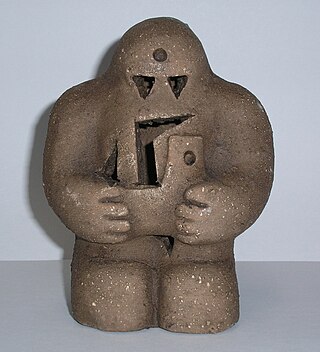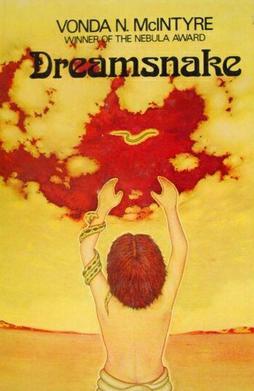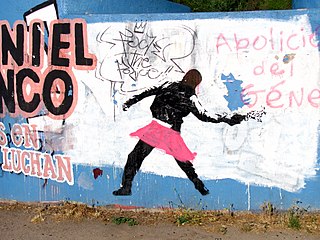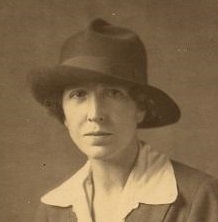Feminist science fiction is a subgenre of science fiction focused on such feminist themes as: gender inequality, sexuality, race, economics, reproduction, and environment. Feminist SF is political because of its tendency to critique the dominant culture. Some of the most notable feminist science fiction works have illustrated these themes using utopias to explore a society in which gender differences or gender power imbalances do not exist, or dystopias to explore worlds in which gender inequalities are intensified, thus asserting a need for feminist work to continue.
Science fiction and fantasy serve as important vehicles for feminist thought, particularly as bridges between theory and practice. No other genres so actively invite representations of the ultimate goals of feminism: worlds free of sexism, worlds in which women's contributions are recognized and valued, worlds that explore the diversity of women's desire and sexuality, and worlds that move beyond gender.

A golem is an animated, anthropomorphic being in Jewish folklore, which is created entirely from inanimate matter, usually clay or mud. The most famous golem narrative involves Judah Loew ben Bezalel, the late 16th-century rabbi of Prague. According to Moment magazine, "the golem is a highly mutable metaphor with seemingly limitless symbolism. It can be a victim or villain, man or woman—or sometimes both. Over the centuries, it has been used to connote war, community, isolation, hope, and despair."

The Dispossessed is a 1974 utopian science fiction novel by American writer Ursula K. Le Guin, one of her seven Hainish Cycle novels. It is one of a small number of books to win all three Hugo, Locus and Nebula Awards for Best Novel. It achieved a degree of literary recognition unusual for science fiction due to its exploration of themes such as anarchism and revolutionary societies, capitalism, utopia, individualism, and collectivism.
Utopian and dystopian fiction are subgenres of speculative fiction that explore social and political structures. Utopian fiction portrays a setting that agrees with the author's ethos, having various attributes of another reality intended to appeal to readers. Dystopian fiction offers the opposite: the portrayal of a setting that completely disagrees with the author's ethos. Some novels combine both genres, often as a metaphor for the different directions humanity can take depending on its choices, ending up with one of two possible futures. Both utopias and dystopias are commonly found in science fiction and other types of speculative fiction.

Octavia Estelle Butler was an American science fiction author and a multiple recipient of the Hugo and Nebula awards. In 1995, Butler became the first science-fiction writer to receive a MacArthur Fellowship.

A gynoid, or fembot, is a feminine humanoid robot. Gynoids appear widely in science fiction film and art. As more realistic humanoid robot design becomes technologically possible, they are also emerging in real-life robot design. Just like any other robot, the main parts of a gynoid include sensors, actuators and a control system. Sensors are responsible for detecting the changes in the environment while the actuators, also called effectors, are motors and other components responsible for the movement and control of the robot. The control system instructs the robot on what to do so as to achieve the desired results.
Marge Piercy is an American progressive activist, feminist, and writer. Her work includes Woman on the Edge of Time; He, She and It, which won the 1993 Arthur C. Clarke Award; and Gone to Soldiers, a New York Times Best Seller and a sweeping historical novel set during World War II. Piercy's work is rooted in her Jewish heritage, Communist social and political activism, and feminist ideals.

"A Cyborg Manifesto" is an essay written by Donna Haraway and published in 1985 in the Socialist Review (US). In it, the concept of the cyborg represents a rejection of rigid boundaries, notably those separating "human" from "animal" and "human" from "machine." Haraway writes: "The cyborg does not dream of community on the model of the organic family, this time without the oedipal project. The cyborg would not recognize the Garden of Eden; it is not made of mud and cannot dream of returning to dust."
The Graduate Student Paper Award is presented by the Science Fiction Research Association to the outstanding scholarly essay read at the annual conference of the SFRA by a graduate student.

Dreamsnake is a 1978 science fiction novel by American writer Vonda N. McIntyre. It is an expansion of her 1973 novelette "Of Mist, and Grass, and Sand", for which she won her first Nebula Award in 1974. The story is set on Earth after a nuclear holocaust. The central character, Snake, is a healer who uses genetically modified serpents to cure sickness—one snake is an alien "dreamsnake", whose venom gives dying people pleasant dreams. The novel follows Snake as she seeks to replace her dreamsnake after its death.

Postgenderism is a social, political and cultural movement which arose from the eroding of the cultural, psychological, and social role of gender, and an argument for why the erosion of binary gender will be liberatory.

Lilith's Brood is a collection of three works by Octavia E. Butler. The three volumes of this science fiction series were previously collected in the now out-of-print omnibus edition Xenogenesis. The collection was first published under the current title of Lilith's Brood in 2000.

Katharine Penelope Burdekin was a British novelist who wrote speculative fiction concerned with social and spiritual matters. She was the younger sister of Rowena Cade, creator of the Minack Theatre in Cornwall. Several of her novels could be categorised as feminist utopian/dystopian fiction. She also wrote under the name Kay Burdekin and under the pseudonym Murray Constantine. Daphne Patai unraveled "Murray Constantine's" true identity while doing research on utopian and dystopian fiction in the mid-1980s.

Woman on the Edge of Time is a 1976 novel by American writer Marge Piercy. It is considered a classic of utopian speculative science fiction as well as a feminist classic. The novel was originally published by Alfred A. Knopf. Piercy draws on several inspirations to write this novel such as utopian studies, technoscience, socialization, and female fantasies. One of Piercy's main inspirations for her utopian novels is Plato's Republic. Piercy describes the novel as, "if only…" Piercy even compares Woman on the Edge of Time and another one of her utopian novels He, She, and It when discussing the themes and inspirations behind it.
Gender has been an important theme explored in speculative fiction. The genres that make up speculative fiction, science fiction, fantasy, supernatural fiction, horror, superhero fiction, science fantasy and related genres, have always offered the opportunity for writers to explore social conventions, including gender, gender roles, and beliefs about gender. Like all literary forms, the science fiction genre reflects the popular perceptions of the eras in which individual creators were writing; and those creators' responses to gender stereotypes and gender roles.
A relatively common motif in speculative fiction is the existence of single-gender worlds or single-sex societies. These fictional societies have long been one of the primary ways to explore implications of gender and gender-differences in science fiction and fantasy. Many of these predate a widespread distinction between gender and sex and conflate the two.
The role of women in speculative fiction has changed a great deal since the early to mid-20th century. There are several aspects to women's roles, including their participation as authors of speculative fiction and their role in science fiction fandom. Regarding authorship, in 1948, 10–15% of science fiction writers were female. Women's role in speculative fiction has grown since then, and in 1999, women comprised 36% of the Science Fiction and Fantasy Writers of America's professional members. Frankenstein (1818) by Mary Shelley has been called the first science fiction novel, although women wrote utopian novels even before that, with Margaret Cavendish publishing the first in the seventeenth century. Early published fantasy was written by and for any gender. However, speculative fiction, with science fiction in particular, has traditionally been viewed as a male-oriented genre.
Batya Weinbaum is an American poet, feminist, artist, editor, and professor. She founded the Femspec Journal, and has published 17 books as well as over 500 articles, essays, poems, reviews, and pieces of short fiction in various publications.

Aurora: Beyond Equality is an anthology of feminist science fiction edited by Vonda N. McIntyre and Susan Janice Anderson and published in 1976.











